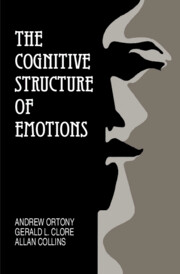Book contents
- Frontmatter
- Contents
- Preface
- 1 Introduction
- 2 The Structure of the Theory
- 3 The Cognitive Psychology of Appraisal
- 4 Factors Affecting the Intensity of Emotions
- 5 Reactions to Events: I
- 6 Reactions to Events: II
- 7 Reactions to Agents
- 8 Reactions to Objects
- 9 The Boundaries of the Theory
- References
- Author Index
- Subject Index
6 - Reactions to Events: II
Published online by Cambridge University Press: 01 June 2011
- Frontmatter
- Contents
- Preface
- 1 Introduction
- 2 The Structure of the Theory
- 3 The Cognitive Psychology of Appraisal
- 4 Factors Affecting the Intensity of Emotions
- 5 Reactions to Events: I
- 6 Reactions to Events: II
- 7 Reactions to Agents
- 8 Reactions to Objects
- 9 The Boundaries of the Theory
- References
- Author Index
- Subject Index
Summary
We often experience emotions in response to expected or suspected events (e.g., fear), and in response to the confirmation or disconfirmation of such events (e.g., relief). Emotions resulting from the consideration of such prospects and their confirmation or disconfirmation comprise the group that we call the “Prospect-based” emotions. In many cases the prospect of an event involves a conscious expectation that it will occur in the future, although, as we shall see shortly, the fact that it appears to be possible for there to be experiences of what might be called “retrospective” fear and relief suggests that this need not always be so. In this chapter we discuss these emotions and a number of related issues.
The Prospect-based Emotions
The Prospect-based emotions are all characterized as reactions to (i.e., being pleased or displeased about) the prospect of an event, or to the confirmation or disconfirmation of the prospect of an event. In those cases involving the confirmation or disconfirmation of the prospect of an event, the most typical cases are ones in which the event has already occurred (or failed to occur) but in which the prospect of the event had earlier been entertained. However, a person can also react to the prospect of an event counterfactually, by thinking about or imagining what it would have been like had the contemplated event transpired.
Information
- Type
- Chapter
- Information
- The Cognitive Structure of Emotions , pp. 109 - 133Publisher: Cambridge University PressPrint publication year: 1988
